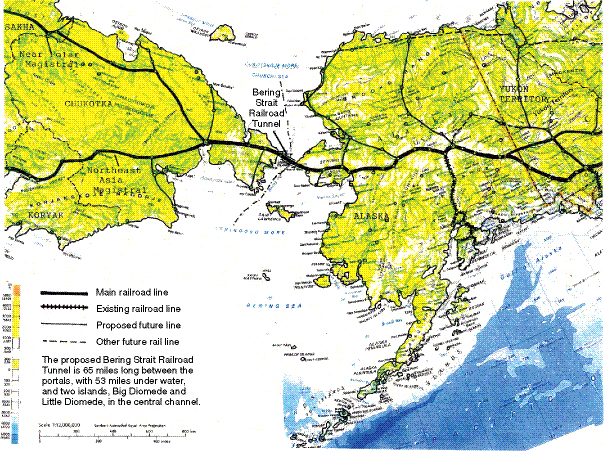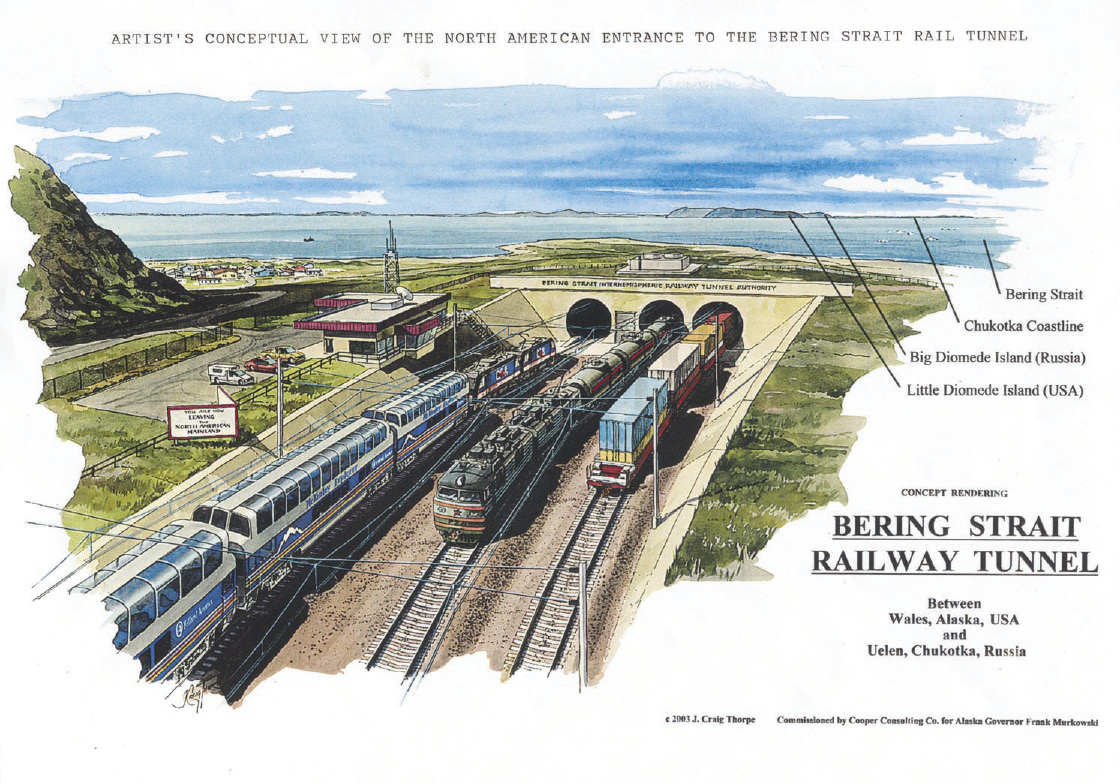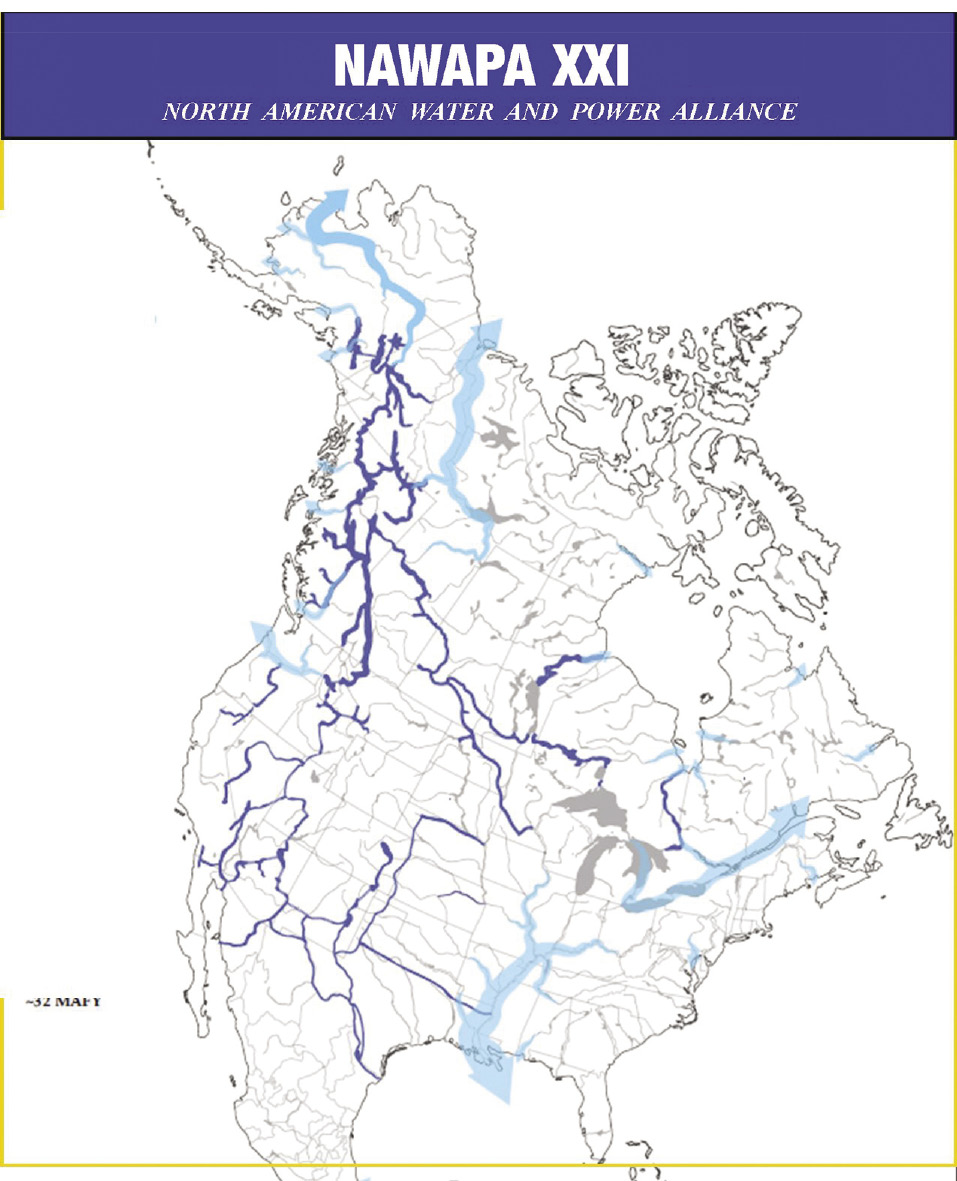 |
NEW WEBSITE: FORUM FOR A NEW PARADIGM
The Extended NAWAPA:
World Rail and Nuclear Power
by Hal Cooper
June2013
 LPAC-TV
Dr. Hal Cooper
|
[This article in PDF format, from EIR]
Dr. Hal Cooper is a prominent American engineer and infrastructure expert. He gave this speech to the June 29 Schiller Institute Conference in San Francisco.
As has been pretty well indicated in this conference, we are at a crossroads: We are either going to follow the British path, with all of the bad things that it entails, or we’re going to follow another path, which is growth, development, and prosperity. And that’s what I’m going to talk about today.
I was asked to talk about three things. The first is California. We heard this morning that there are some serious water problems affecting our farming. Water has been severely restricted to the farms in the San Joaquin Valley. A lot of the land in farming has gone fallow. There is a preference for protecting fish in the delta, as compared to farms for growing food for people. The real problem is we have too many demands and not enough supplies for water. And the North American Water and Power Alliance (NAWAPA) project, with its extensions into California, as indicated in the most recent versions of the documents published by the LaRouche movement [http://larouchepac.com/infrastructure], really shows that.
We have agricultural demand which we’ve heard about; we haven’t heard much about city demands. Southern California actually has a preference over the water rights in the San Joaquin Valley, which they are now being forced to appropriate, because they are losing their access to the water in the Colorado River, which is being taken by Arizona, because of the prolonged drought in the Southwest.
|
FIGURE 1
The Monterey Shale Formation
|
There’s another demand: hydraulic fracturing of oil production. California has very large reserves of oil in the Monterey Shale (Figure 1). Some sources say it’s substantially larger than the Bakken formation in North Dakota, which I’m working on right now. It’s going to need water. Cities are going to need water, towns are going to need water, farms are going to need water. And we need to protect the water.
Governor Brown recently proposed building two tunnels, from Cortland on the Sacramento River, south of Sacramento, to Tracy, where the intake to the present California Aqueduct and Delta Mendota Canal is; and we’ve heard this morning that the San Luis reservoir, west of Los Banos, is at a very low level, and is not going to be able to sustain the needs of farmers and other water-users in the Central Valley. So we need to get another source of water: Which is the North American Water and Power Alliance project, which will add the water in the Upper Columbia River, at Micca Dam, in central British Columbia, coming from the Northwest Territories, Alberta, British Columbia, Yukon and Alaska, from the Yukon and McKenzie River Basins, which flow into the respective Pacific and Arctic Oceans.
We need to have that water: Having it come down the Columbia River, being able to increase the hydroelectric generating capacity of the dams on the Columbia River, and then, pumping the water south into eastern Oregon, into Goose Lake and the far southern Oregon, into the Pitt River Basin, which flows into the Sacramento River.
And we have another need for water in the Klamath River, which actually starts in Oregon, and goes into the far northwest of California; and right now, farmers and ranchers are going to be shut out of water, because the Indians have been given a preferential right to it by the Bureau of Reclamation of the U.S. Department of the Interior.
We Need More Water
Actually, this goes back to earlier times; when there was a lot of flow, the salmon and other fishing rights of the Indians were protected. But at the same time, there was enough water. What we need to do is add enough water to offset what has been taken out, and then, there’s water for everybody. That is one option that has not been considered. And the taking out of dams is not a smart idea! And that has become, basically, an official policy, and it actually exacerbates the problem, it doesn’t solve anything.
What we need is more water, and it can’t come from Oregon and California, it’s going to have to come from somewhere else: And that means the North American Water and Power Alliance project, which this organization has greatly promoted.
The Monterey Shale oil development, the first leases were just awarded in February of this year. How much and to what extent that oil development takes place remains to be seen. However, the oil and gas industry has enormous influence, and if it says it needs more water, it will get it. But we don’t want it at the expense of existing users, because right now, the fact of life in California, is that any new use of water has to take it away from an existing use. And without NAWAPA, we can’t solve that problem.
|
FIGURE 2
|
In addition to that, oil production takes a lot of people. It’s probably the most employment-intensive of the energy sources we have. I can certainly attest to that, working in North Dakota.
The California High-Speed Rail project—the construction contract for the first 26-mile section, from Maduro to Fresno (Figure 2), was awarded two weeks ago. That’s good. There’s been a lot of controversy about that project. What has been proposed needs to get built; but there needs to be another line along the west side of San Joaquin Valley, right next to Interstate 5, right next to the California Aqueduct, including to get people to work. And that would help a lot of things.
And of course, all those projects need to happen: the canal, the tunnels, the high-speed rail, the water, and the oil. California’s economy will be drastically transformed if that happens. It will certainly not follow the British model, or the Greek model. It will following the North Dakota model. It’s remarkable, the work in North Dakota, where they have a huge budget surplus, that probably is much greater than they say it is. Everybody who wants a job has one. Maybe they can’t all find a place to live, but they can certainly find a job.
The Bering Strait Tunnel
Now, the Bering Strait Tunnel (Figure 3): There’s been discussion about it, and sadly, in North America, primarily in this [the LaRouche] group; there hasn’t been much official discussion. But the real goal here is to connect Asia and North America together. The Russians are already working on it. They’ve already built the first section; it’s been in operation since December of 2011, from Neryungri to Nizhny Bestyakh, across the Lena River from Yakutsk. They need to build a tunnel or a bridge under or over the Lena River, to connect the capital of Yakutsk.
|
FIGURE 3
The Bering Strait Tunnel  |
The second section, which would go to Magadan on the coast, by way of Oymyakon, in the Magadan region, is being designed now. They are planning to build, initially, single-track diesel, later, double-track electric, and a four-lane highway, and electric transmission, and probably natural gas pipelines too. And of course, that will all facilitate the development of northeastern Russia, whether or not the Bering Strait Tunnel gets built. It’s just that if it does get built, it’s going to generate much more traffic.
Eventually, over a 20-year period, their plan is to build out to the Bering Strait, and it will end in the far northeastern end of Chukotka, right across the Bering Strait from Wales, Alaska, and the Little and Big Diomede Islands. There’s no such effort in the United States.
However, Alberta [Canada] is in the middle of a big battle right now, in the middle of the Keystone Pipeline right now, which I’m sure most of you have heard about. Whether or not the Keystone Pipeline gets built remains to be seen—however, the oil and gas industry has suddenly gotten very comfortable moving oil by rail, especially in North Dakota: There’s over 5,000 barrels of oil a day being moved out of there now by rail. I’m working on some of that. And if Alberta is unsuccessful in getting pipelines built out to the west coast of British Columbia, because of opposition from the British Columbia government and the environmentalists, and the First Nations, etc. because of concerns over oil spills, we’ll just put it on a train and haul it to China. The only problem is, you’ve got to build the Bering Strait Tunnel to do it!
That’s a good way to sell it.
Because, next to those large banks, that Michael [Kirsch] and others have talked about in terms of their influence, probably the industry that has virtually as much influence, is oil and gas. And if they decide they want to haul it by rail, very likely it’s going to happen, and we would have developed ourselves a very powerful ally.
I presented this idea at the Oil Transport Conference in Houston in March, starting with building a railroad from North Dakota to Texas to haul oil, and the first question that I was asked when I finished my presentation, was, “Mr. Cooper, when are you going to start building this railroad?” This is coming from people in the oil business! These are not government people, they’re not rail lobbyists or fans. They realize the necessity.
So, a strategic corridor.
And there’s one other major source of traffic: Right up there in the northwest of Alaska is a huge coal deposit, at Point Lay. It’s owned by the Arctic Slope Regional Corp., which is the largest of the native corporations in Alaska. They have tried to develop their coal, with previous work with BHP Billiton, at least, and probably others, but nothing so far has happened. And they need to build a railroad. So far, no one was willing to build it. But if it gets built down to where the rail line to the Bering Strait Tunnel is, lots and lots of coal can get moved to China, along with lots and lots of oil from Alaska, Yukon Territory, and Alberta. And you’ll probably see a change in the view of the Canadian government about whether they should support the Bering Strait Tunnel, because, while they’re certainly a part of the British oligarchy, their economy is based on oil and gas. So there’s a reason for them to be thinking about that.
|
FIGURE 4
|
Now, this is what a conceptual view of the Bering Strait Tunnel entry point at Wales, Alaska would look like (Figure 4). It’s a painting done by Craig Thorpe. We show three tubes. Out there in the middle is Little Diomede Island, and behind that is Big Diomede Island, and way off in the distance is the Chukotka coast of Russia. It’s 53 miles, by the shortest distance, a tunnel about 65 miles long. Actually, in some respects it’s an easier tunnel to build than the English Channel Tunnel.
Now, the Russian government, the Russian Railway, is really, very much interested in seeing this developed, but there is one logistical problem that has to be addressed, because it affects other parts of their system, and other systems as well. And that is, the gauge is different, by three and a half inches: It’s just enough that you can’t run from one system to the other. My own personal opinion is, you should have a dual-gauge, double-track railroad, at the minimum. And possibly, two main tracks: A standard gauge going to China, and two Russian gauge tracks.
And on the Trans-Siberian Railway, there is now a great interest by the Russian Railway in moving lots of cargo from China to Europe, so they don’t have to run on the British ships through the Suez Canal and the ocean, which takes them much longer. The costs, believe it or not, are almost equivalent. And if the Russian Railway can increase its transit speed, and reduce its transit time between China and Western Europe, they’re going to get a lot of business. They already have plenty, but they were going to get a lot more. I think adding additional tracks to their standard gauge would probably help.
And of course, it’s definitely a superior alternative to dealing with the British oligarchy on the ships, which has always been their concern. Of course, there are people in the LaRouche organization, and that includes myself, who believe that World War I was started to prevent the first effort to build the Bering Strait Tunnel.
The Darién Gap
|
FIGURE 5
Proposed Route Options for the InterAmerican Railway Through the Darien Gap of Panama
Source: Hal Cooper/EIR
|
Now, Latin America: While there’s been a lot of talk about the Bering Strait, there hasn’t been that much about the Darién Gap (Figure 5). It’s possible to build a rail connecting Panama and Colombia, which really would mean Mexico and Colombia, through Central America; and it’s about a 1,700-mile railroad. And once we get into Colombia, we can have rail lines going into Brazil, and Argentina, and Chile, and Peru, and Ecuador, and Venezuela! And we should.
And I think that’s something that needs to be done. And the new President Enrique Peña Nieto in Mexico has talked about wanting to have joint development projects among the United States, Mexico, and Canada—maybe a high-speed rail line from Monterey to Mexico City would be a good idea.
But, connecting to this main rail line going up to the Bering Strait would be another one, and preferably from the freight standpoint, a good idea. But we could be hauling lots of cargo in that, and we would open up that entire region for economic development: four-lane highway, double-track railroad, at least; electric transmission lines.
There are efforts to build electric transmission lines between these countries, but so far, I’m not aware of any governmental efforts to really start to build a main railroad through all of Central America. But there should be.
There are some mountains to cross. The line would probably be built on the west side, because the logistics are easier, and it’s more direct, and you serve more of the population in the cities. But once you get into Colombia, and you have to go across the Tumarando Swamp, and go through the Darién Gap, and so forth, with overhead viaducts, and maybe a bridge over the Gulf of Urabá at northern end of Colombia, but after that, you’re going to be going up in mountains, as much as 7,000 feet.
And of course, the Andes Mountains are a formidable barrier to building railroads. Believe it or not, there is a railroad that’s now being proposed to be built between Mendoza in Argentina, and Santiago, Chile, for the purpose of trucks being hauled through the mountains. But it’s going to require tunnels, and there was a proposal to build a line from Ecuador to Brazil to haul iron ore, so it can come out to China.
And China has been very good about investing not only in Africa, but also in South America. And I think the difference between what they’re proposing to do, and what the Obama Administration is proposing to do, is, the one brings development, the other brings conflict, which certainly doesn’t sound like a very productive type of activity at this point.
And NAWAPA: NAWAPA, in conjunction with rail, with energy development for electricity, is essential for all this to happen (Figure 6).
|
FIGURE 6
|
 |
And the world railway system (Figure 7). This is a map I developed a long time ago, I think back in 1997, or ’98, and of course, it’s been extensively shown, but this really is the concept of what we really need. We don’t need the British oligarchy breaking everybody down into little compartments, and manipulating everybody, and keeping everybody in poverty and starting wars and all that foolishness. We need economic development for the benefit of mankind.
I thank you.



 View full size
View full size 
 View full size
View full size